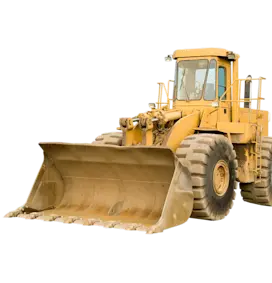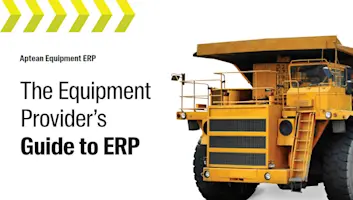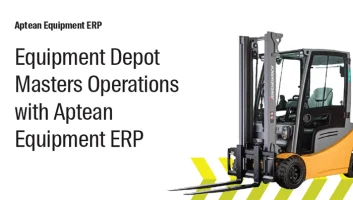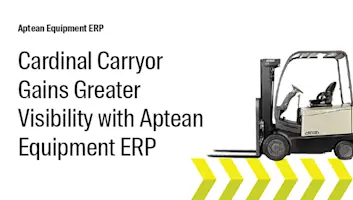In diesem Beitrag vorgestellt
Beginner's Guide to Dealer Management Software
Beginner's Guide to Dealer Management Software
1 Juli 2021
Aptean Staff WriterBlog-Beitrag
- This guide is written to help you understand how Dealer Management Software can help you with your growth as an Equipment Provider.

When Do You Need ERP?
In the earliest stages of your business, when virtually every transaction was done manually, you found that switching to an accounting software system gave your company a boost in efficiencies. As your company grew, you saw you were outgrowing tools like spreadsheets, email, your accounting software and/or other disconnected applications.
Meanwhile, the information needed to take sales orders, dispatch the service technicians, move equipment in and out of rentals, replenish parts, and many other vital business processes remained locked inside the heads of key employees and not in a centralized, integrated system!
Once your business starts to grow in size and/or complexity, your management starts wanting, and needing, to measure everything related to all aspects of the business. The various spreadsheets or disconnected ‘sidecar’ applications that the company has been making do with to manage data falls short of accurate, timely metrics. Only an integrated software system, such as ERP, offers a single version of accurate data visible to all employees, so that key performance indicators and benchmarks can be set to measure performance—and automate workflows.
Now, with Business Software, Dealer Management Software, ERP or whatever you choose to call the software that will help run your business, you can move into the stages of Measurement, Control, and Improvement that are the signs of a mature, thriving company. Technology roll-outs during these later stages could be called ERP+ wherein the software extends its transactional reach into data management and analysis for all movements, such as Price, Configure, Quote functionality, Field Service Automation, e-Ship and EDI.
Why Do You Need ERP?
There are a lot of moving parts in the business of being equipment provider, as you know. An ERP software system built specifically for your industry, can handle all the vital functionality required, including:
Dispatch board
Service manager dispatches all service requests to technicians. Requests are entered into Aptean Equipment ERP; can be filtered by type of requests, by customers, equipment, etc.
Can customize visibility of the dispatch board, depending on roles set up.
Robust functionality: all task scheduling done in a single screen.
Service contract management
Covers both contract maintenance billing and planned maintenance, which can be run together, or run separately to manage two different processes.
Users can enter the contract with a customer to do service cycle, for example monthly or every 90 days, or can be done on hour/meter readings, instead.
Service Planning Worksheet – one-click to run this worksheet, which will suggest the service work orders that need to be created based on your contracts.
Automatically generates all service orders, which then show up in the Dispatch Board to schedule technicians.
Technician availability
Ability to view the availability of all technicians on staff – can view by day, week, month, quarter and year.
Unlimited number of technicians can be accessed in this view.
Technician can be allocated to a job from the availability view.
Can pull up all the service work orders allocated to each technician directly from this availability view.
WIP order & labor
Full visibility into what service orders are still open.
Visibility into how much technicians’ time is left to be allocated per service order, to maximize billing time.
Field service
Access mobile work orders, customizable, coded PM, parts and inventory tracking, warranty tracking, timekeeping, customer data, today’s schedule, etc.
Capture performance data of employees – service time, tasks, expenses, etc. Integration with enterprise mobility platform that allows for easy development of custom mobile applications.
Integration with telemetry services, such as Speed Shield, for meter readings on equipment and other functionality.
Rentals Functionality That Supports Your Business
The equipment rental industry has been growing at a rate four times more than the general economy for years now, according to ARA statistics, and equipment rentals are poised for even greater growth in 2014. To get the most out of this thriving rental market, equipment providers need to use software technology to squeeze out all the inefficiencies in rental contract management, shipping, billing, and fleet management (whether 100 or 30,000 units) and more.
Availability tree
The sortable availability tree within the Aptean Equipment ERP software lets users filter by equipment type, model, manufacturer, location, capacity, fleet size, what is on rent, etc.
Rental contract management
Contracts or quotes can be generated for customers with one click right from the availability tree.
Quotes can be converted to rental contracts (partial or completed) with the system keeping track of those won or lost, recording the reasons for both results.
Serialized and non-serialized items can be on the same rental contract, if desired.
Training is efficient with rental contract “wizards” (pop-up windows) that guide users through all the steps required for creating a contract.
Rental contracts inter-relate with required service work, such as pre-delivery inspections, check-in inspections, etc.
Service orders created from rental contracts are updated automatically in Service Dispatch.
A rental exchange wizard walks users through the steps needed to find replacement equipment for customers.
At the end of a rental contract, the end of contract wizard helps the user finalize the charges, including adjustments for mid-period return as well as any additional charges such as pickup, damages, etc.
User can cancel the entire contract or selected units within that contract.
Cross-department hub
Service (work orders), purchasing and other day-to-day functions can be performed right within the rentals module.
Strong integration with evaluation information your employees use every day – such as current book value, profitability for period to date, year to date, lifetime to date, etc.
Data can be exported to Microsoft Excel, allowing for more time analyzing information by your employees.
Earned and accrued rental income is easily and quickly calculated in an analysis schedule to allow for accurate financial reporting.
Shipping
Warehouse shipment is automatically generated, with availability status updated accordingly.
Units can be returned to the originating branch or to a different branch.
Billing
The next billing, if desired, can automatically move from daily to weekly to monthly, depending on the most advantageous rate for the customer.
Rental contracts, and resultant invoices, can be set to automatically add applicable charges – by customer or by equipment category – for insurance, delivery and pickup charges, etc.
Fleet management
Can manage fleet sizes from under 100 units to 30,000 or more.
Improved and simplified fleet maintenance.
Comprehensive fleet and asset utilization details.
Minimized or eliminated paperwork.
Enhanced quality of information available to share with customers.
Logistics/Warehousing
Users can concentrate equipment receipts, shipments, and transfers under a single logistics/warehousing function.
Sales Functionality That Supports Your Business
Sales orders
The sales order is the hub of the sales system; users can create and view most documents from there, and navigate from the sales order to other parts of the Aptean Equipment ERP system.
An automated approval request can be emailed to designated employees regarding a sales order or quote, if desired. Then the requester receives an email that the transaction is approved or rejected.
Users can easily convert quotes to sales orders; all details from the quote follow the order.
The ability to keep track of lost and changed quote.
Integration with service & purchase orders
Automatic generation of the service work order and purchase order, if needed, from the sales order, such as for pre-delivery inspection service tickets, etc.
Upon receipt of equipment, the purchase order will automatically create the applicable equipment record(s).
Service orders can be capitalized or expensed to the unit worked on.
Cost of sales will automatically adjust for service orders capitalized after sale of the unit.
Logistics/Warehousing
Consolidate all equipment pickups, deliveries and transfers into a single planning sheet.
Schedule and dispatch transportation/logistics runs.
Manage paperwork via logistics document packages.
Lease management
Accounting functionality to properly record sales type lease arrangements.
Utilize a built-in lease calculator to define types of leases, lease rates and maintenance rates.
Order equipment and generate recurring lease/maintenance billing contracts.
Manage accounting schedules or sales type lease arrangement.
Trade-ins
Equipment order screen allows for management of trade-ins: User enters make, model, value of equipment, and allowance value for the sale.
Customer relationship management (CRM)
Opportunity management and campaign management to help your sales people get the most from marketing opportunities.
Access to customer and work order histories, parts availability, and delivery schedules.
Integration of contact information to smartphones so there is no lag time in contacting prospects and customers.
Sales management has immediate visibility into sales activities to make faster, better decisions.
Parts Functionality That Supports Your Business
Inventory management
Ability to upload vendor parts catalogs.
Physical inventory capabilities – automates the running journals that print off cycle count sheets for the warehouse.
Ability to maintain and track supersedes –part A replaced by part B; functionality allows you to link them together and prompts you to use up part A first.
Safety stock level fields for all parts; ability to calculate what the safety stock levels should be based on average calls or days’ supply.
Manage obsolescence by having the system automatically change part statuses at a location based on conditions such as aging and movement.
The ability to manage and track cores with customers and suppliers.
Replenishment
Ability to set different stocking levels of parts by branch or location or van.
The capability for MRP planning (supply methodology) – running work sheets to look at quantity of parts on hand.
A bility to easily transfer parts between branches.
Manufacturer parts
Price tapes from manufacturers can be imported directly into the Aptean Equipment ERP system (all the costs, pricing, and does automatic calculating).
Handle parts from different manufacturers with ease.
Equipment Management Functionality That Supports Your Business
Transfers
Users can fully control movement between new equipment, used equipment, and rental fleet. For example, moving rental units into used for sale. Change of ownership is also tracked as equipment moves.
History
Entire history of equipment stays with the piece of equipment forever - from purchase to rental to sale to repurchase, etc.
Warranty management
The capability to track warranty claims against specific equipment.
Component & attachment management
The capability to manage serialized cabs, engines, forks, and other components and attachments.
Financials & Reporting Functionality That Supports Your Business
Financials
General Ledger provides ability to set up a company and post to the general ledger including setup of chart of accounts, general journals, recurring journals, and source codes.
Full data export to Word or Excel using style sheets and adding links to external documents.
Allocations, budgeting, account schedules, consolidations, responsibility centers and financial reporting standards, change log, intercompany transactions, dimension, bank reconciliation, and multi-currency support.
Accounts Payable and Accounts Receivable are integrated with General Ledger and Inventory.
Support for Electronic Funds Transfer, printing of MICR encoded checks, positive pay, and other advanced features.
Reporting
Support for tactical and operational reporting.
Detailed reporting in real-time via Excel reduces users’ learning curve and removes the dependence on IT departments for report writing.
Easy-to-use report features that integrate Excel functions like charting, pivot tables, and conditional formatting.
Analytical and Business Intelligence (BI) capabilities through Excel or Web-based user interface.
Costing
Automatic accrual of equipment received but not invoiced.
Item Charge Assignment functionality allows you to associate related costs against items or documents; handy for freight, duty, storage, and other associated cost.
What Are the Benefits of ERP?
While ERP software is no small undertaking at a company, it does bring many benefits to your business, just to highlight a few:
ERP boosts efficiency and reduces errors in all departments by automating data entry and processes.
ERP supports decision making by management since vital information about any part of the company can be viewed immediately.
ERP improves data security, and keeps the company’s precious jewel – its knowledge - from walking out the door when key personnel leave.
ERP makes companies agile - more flexible and quicker to change to business demands - and therefore more competitive.
Faster and more accurate outputs ultimately lead to happier customers.
ERP fosters collaboration of knowledge, within and between departments, as all employees can create and share information easily and quickly.
So You Think You Are Ready For ERP?
Not all ERP software is created equal, so here are some points to help guide you in your selection process.
Which industry does the functionality within your ERP software best suit?
Do you have up-to-date IT certification as validation of specialized knowledge in ERP?
What is involved in the upgrade process of your ERP software?
What is the long-term product road map of your software, i.e. what kind of R&D investment is being made to your ERP?
Which customers may we speak to about your ERP and how it serves their companies?
Will you use our actual business data to do a software demonstration?
What does after-sales support of the ERP product involve?
What has been the trajectory of growth in customer base and revenue at your software company?
Related Content


Sind Sie bereit, Ihr Unternehmen grundlegend zu verändern?
Wir bieten Ihnen die spezialisierte Branchensoftware, die Ihre Organisation voranbringt.






